Philippines Special

|
• Flamenco Beach Resort • Ramada Ras Sudr Resort • Sheraton Soma Bay Resort • Morgenland Hotel St Catherine |
I’ve never thought about “green stars” before. But this special has me thinking of some way to recognize its significance so you’ll also give it its due. No single ‘part’ of this is exceptional. The photography is very good considering it came from a point and shoot, and the narrative to a lesser extent. Some of the images are very average, some much better because of his previous knowledge of photography. But not exceptional.
The cliché “it’s about the journey” is what makes this stand out on its own. The correspondence we had discussing film vs. digital, his previous experiences with film and his new experiences with digital. The thought process, the discovery of what digital has to offer, and the certain knowledge that while film still has much to offer.. digital is fun and motivates us to record and document our travels in ways we never did before. The journey which has been taken by many before, is exceptional because its well documented, reasoned, and discussed.
Green Star material? Hell yes!
Over the length of several months Tom Parson’s and I exchanged emails. He wrote in some questions for the weekly column which I thought quite interesting. If you search back through the weeklies you’ll see his questions in the Readers' Questions
area. Here was a man who had used some of the finest equipment of “yesterday”, equipment I dreamed of but couldn’t afford when I was shooting my Olympus film SLRs.
Our discussion centered around the great debate of our time, film vs. digital. He reminded me so much of myself, of the questions I asked myself before I got into digital. 15 years ago our thoughts would have mirrored each other. Today however, after 15 years of digital experience, I was confident that while his views might not change.. he could certainly add to his equipment and enhance his photography experience in the process.
Secretly I was hoping his “discovery” of digital would also mirror my own experiences. Hopefully soon he would discover what I discovered, which of course would validate my own findings. Would this make me insecure, or egotistical? Either way it doesn’t sound complimentary.. ;o)
A few months passed and I didn’t hear from him and then out of nowhere I see he sent me an email. Checking the email I see an attached Word document so I open it up and start reading. The narrative is ordinary, but the photography was very good. It was great if you consider it came from an ordinary point and shoot camera! The entire trip report was on the Philippines and within the realm of interest to our readers and instantly I wanted to post this for everyone to read.
Tom put a lot of work into this and the images and narrative is very interesting. But what’s more interesting is his thoughts and decision making process on whether to continue using film, or to give digital a try. What turned out happening might surprise most of you. Below is an excerpt from the final summary he sent me:
Surprise: I exclusively used the Lumix LX2 compact point and shoot. It was just so convenient to have it with me in a small belt pouch wherever I went; I never felt the desire to burden myself with another bag. Still, there have been a couple of situations where I would have loved to use the Contax, but how much sense does it make to come home with 900 digital and 100 analog images? That would have left either series incomplete.
How many times have I posted in this weekly that many of you would be very satisfied with your compact point and shoot if only you maximized its potential? Tom Parson’s does a great job of demonstrating just how satisfied you could be!
Thank you Tom! This is really good work and I enjoyed your trip report immensely. I posted your final summary at the end of the trip report and I’ll post some comments to your conclusions.
Great Work!
Steve
______
So, after so much theory, now a few pictures. All were taken with my compact Panasonic Lumix LX2. Most are JPEGs right out of the camera, without any post-processing except reducing resolution
and increasing compression to make them suitable for internet usage. I cropped a handful somewhat, and just a few that I think are easily recognizable were submitted to some more serious post-processing.
In one of your recent articles, you wrote about image quality from compact cameras versus DSLRs. I agree with you and do believe that my pictures show that it is indeed possible to get reasonable quality out of a compact. Especially if you keep in mind that they show only 3% of the original resolution and are highly (and visibly!) compressed.
Ok, let’s begin with a portrait series.
Filipino people love to be photographed. Just walk around with a camera — even a small unsuspicious camera like mine — and it won't be long until someone yells "Hey Joe, picture!" at you. (“Joe” in the Philippines equals “Farang” in Thailand.) Be warned: If you take his or her picture, accompanied by a lot of laughter on both sides, of course, you will have to stay there for quite some time. Because the next one will ask you (well, make this "demand") to be photographed, and the next one, and the next one…
Here are a couple of pictures I took this way, all within about half an hour, in the Baclaran area of Metro Manila — Pasay City, to be exact. Baclaran is one of the biggest transportation hubs in Manila, with two Metro lines intersecting with two of the busiest roads of all Manila, and hundreds of Jeepneys and buses going to virtually all directions. You meet lots of friendly people of all walks of life there.
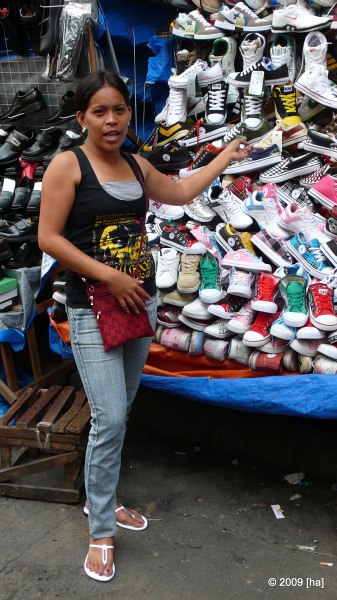
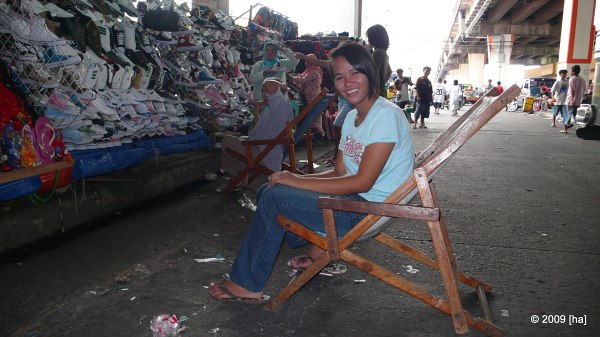
In the picture above, I used the built-in flash as a fill-in. I think, however, that it is too strong. If I had had a second chance, I would have reduced the flash power by 1/3 of an f-stop.
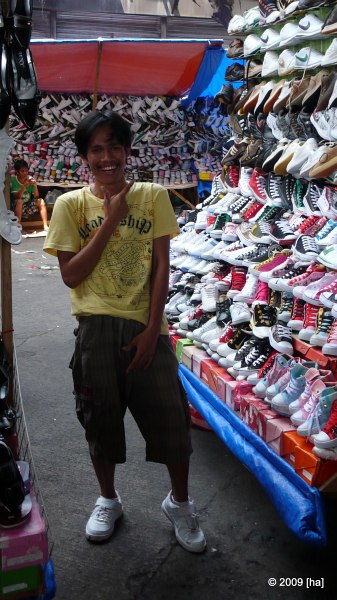
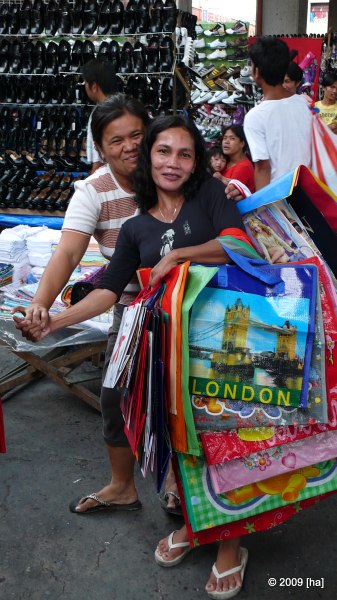
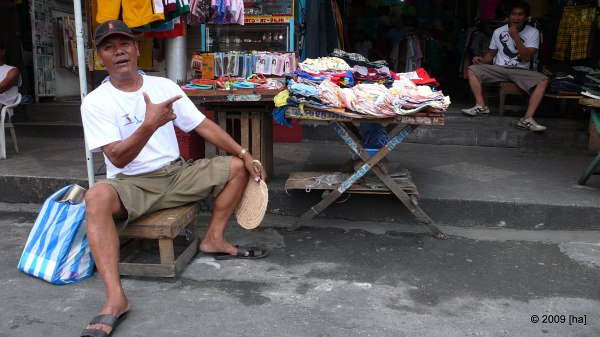
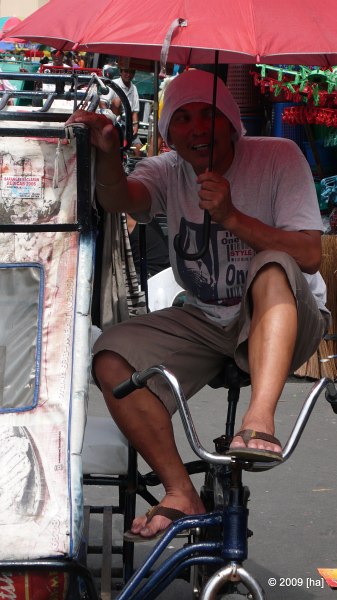
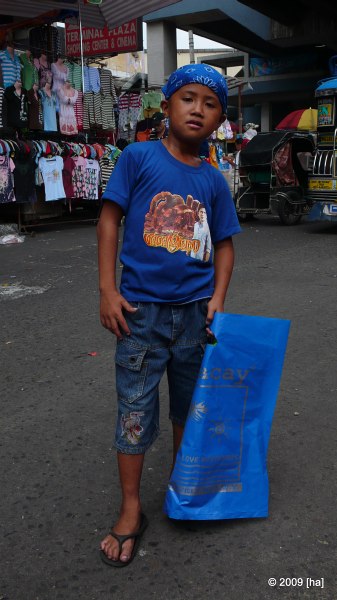
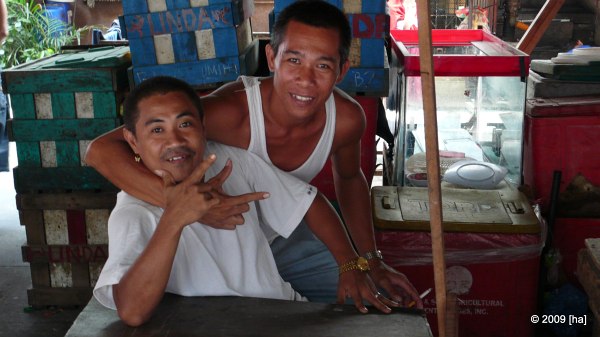
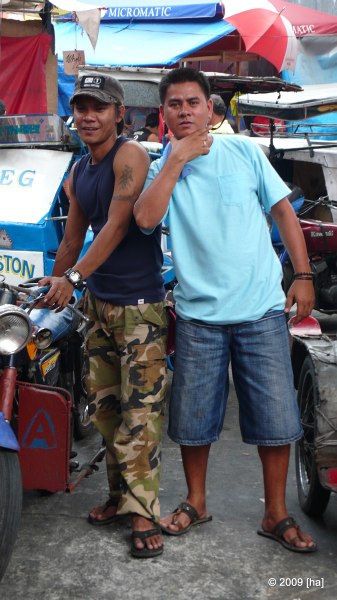
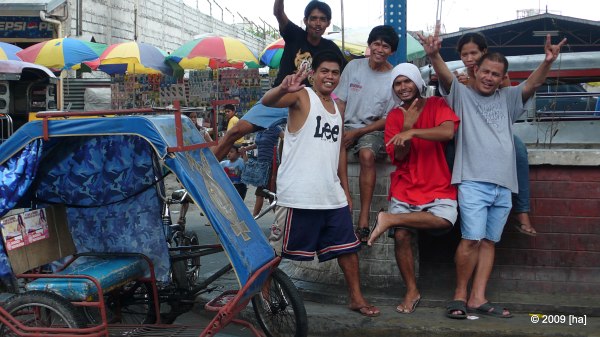
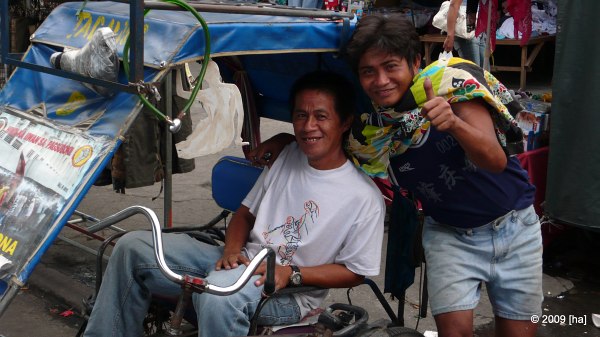
The above pictures clearly show a compact camera’s biggest drawback: The “always on” depth of field. It is practically impossible to have an out-of-focus background. As much as possible under the given circumstances, I tried to compensate for this problem by appropriate composition.
Another experience: Normally, I don't like zoom lenses very much because of their slow speed, strong distortion, and sensitivity to glare, as well, at least in SLRs, bulky size and hefty weight. Here, however, I was glad to have one. In crowded places like this, your possibilities to "zoom with your feet" are very limited, and your subjects probably wouldn't be patient enough to wait until you have changed the lens… Another option would be to always use a wide-angle lens and do the cropping afterwards on the PC, but, as I said, as an old slide photographer that method doesn't appeal to me.
Back to the Philippines. Leaving Baclaran now and going to Roxas Boulevard in order to watch the famous sunset on Manila bay… Actually, when I was there with my camera, it wasn't *that* special, but I still got a few nice shots
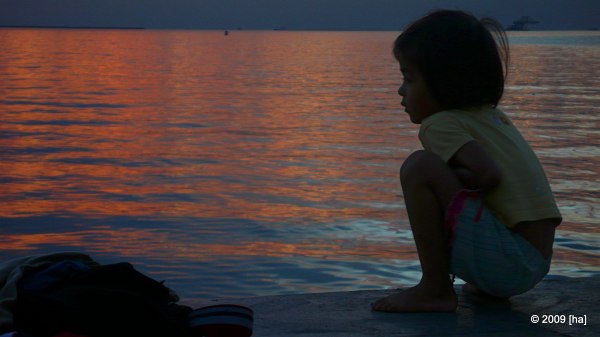
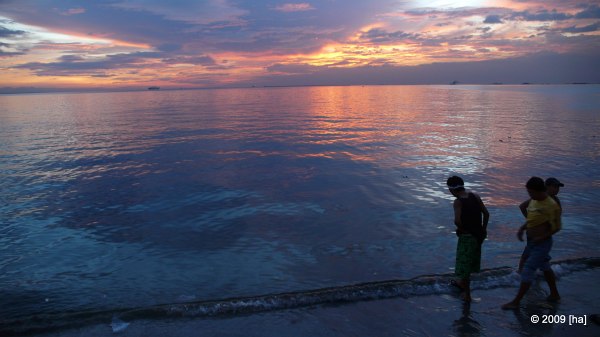
Ok, let's get out of Manila now. I took the night bus up to Banaue in Northern Luzon, known for its UNESCO world heritage rice terraces.
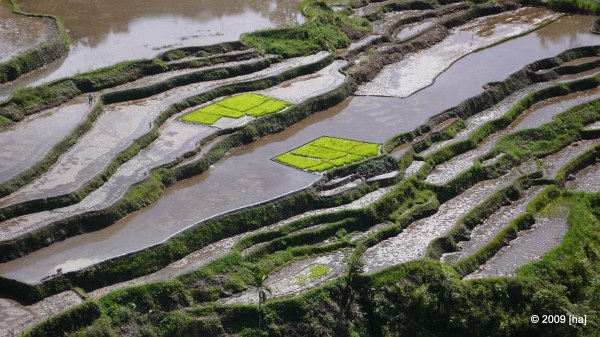
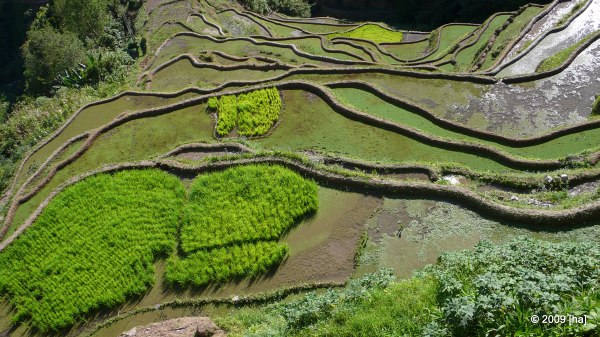
But there's more to see than just rice terraces in this small town. For example a tiny girl sweeping her school's gym. I liked the visual contrast between her red clothes and the gray concrete floor:
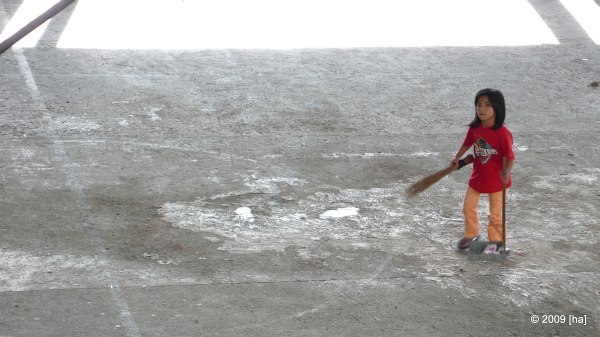
Tricycle "cabbies" waiting for customers in Banaue's main square:
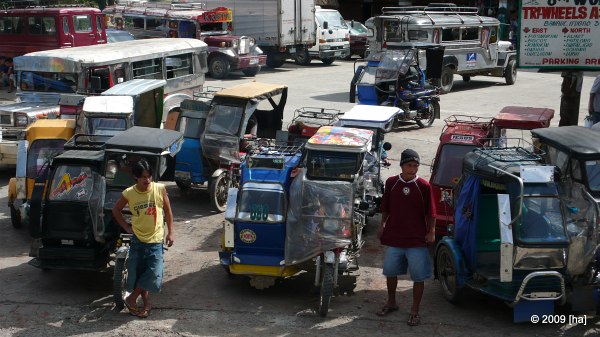
And a few old ladies adding to the family income by posing for the handful of tourists who make their way up there, for a small tip:
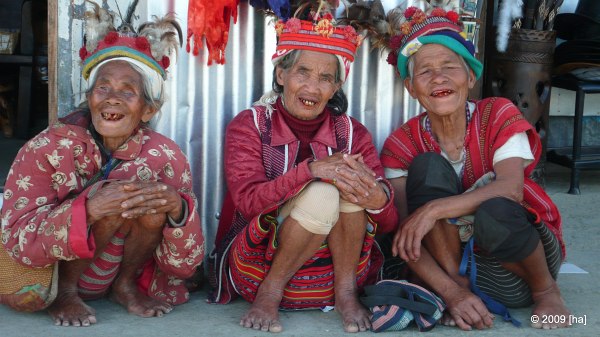
A Jeepney ride over dusty and mostly unpaved roads away: Sagada. It's a nice and peaceful mountain town, relatively wealthy because it is on the tourist roadmap. And that's not just because of its peace and quiet but because of its hanging coffins
and burial caves:

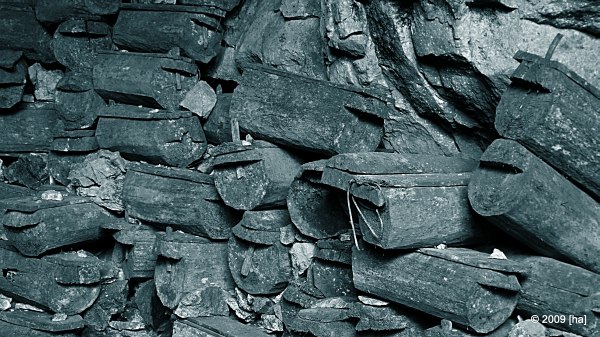
As you can see, I have done some post-processing on the pictures above. Because of the dim light in the cave and the weathered wood and stone, they were almost monochrome anyway, but in an unattractive grayish-greenish hue. Also, contrast was very low and superseded by some motion blur. Crops are out-of-the-camera. I actually quite like the results.
We are going on to Baguio now, the so-called "Summer Capital of the Philippines" because of its relative cool and clean air.
I don't know about you, but some of the most fascinating sites (and sights) for me when I am on the road are a) bus terminals and b) markets. The coming and going, the smells and sounds, well, the general atmosphere — I could walk around such places for hours… In the Philippines, except in smaller cities, there is not a single central bus terminal but each bus company tends to have their own. Here are a few samples of one of those in Baguio:
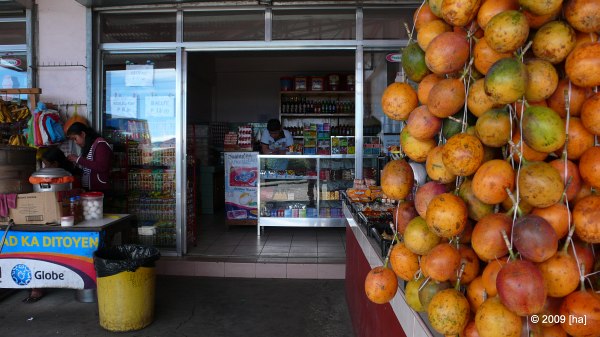
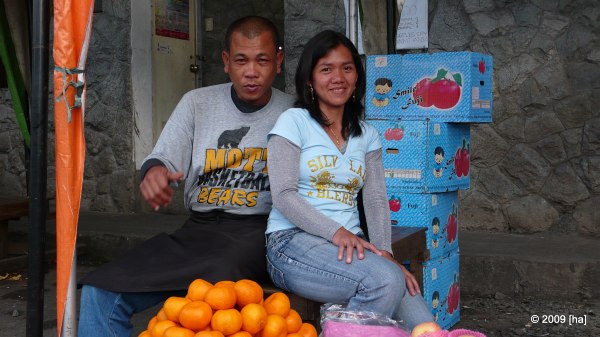
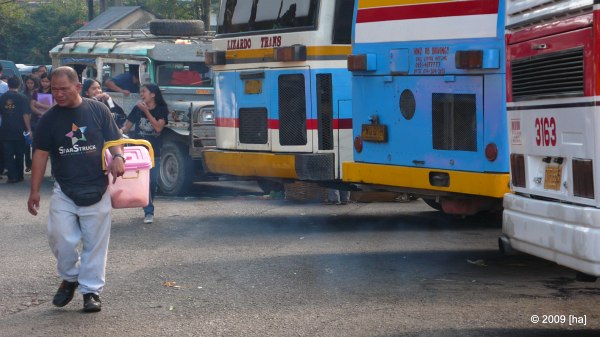
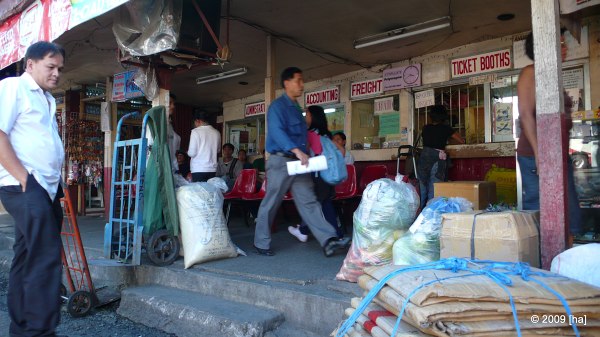
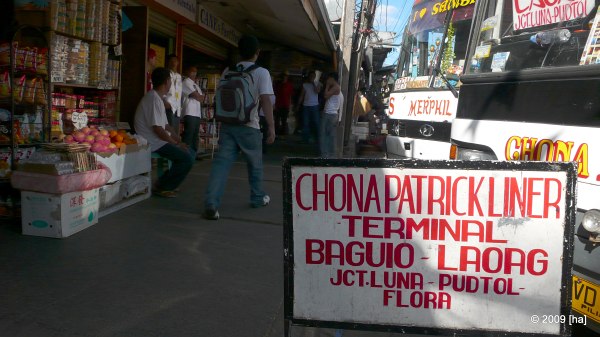
And then, the market in Baguio. It's huge, and I don't want to bore you with the 30 or so pictures I took there; just a few of my favorites:
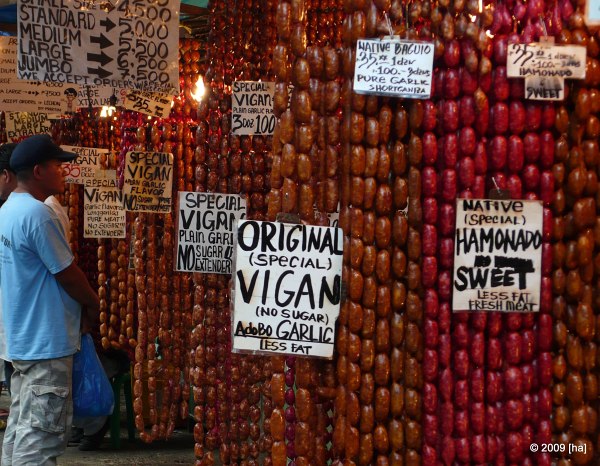
I haven't actually tried one of those…
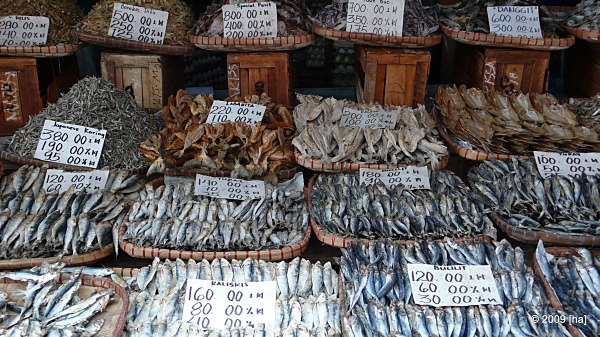
The next three pictures can also be considered portraits, but I took them in a very different way from the Baclaran shots. The subjects were not posing for me, and, in fact, were not even aware that I was taking their picture. I did it by pointing the camera without looking at its viewfinder screen. Often, of course, you can delete the result immediately afterwards, but sometimes, quite interesting pictures result.
I particularly like the next one. I don't really know why, but it has a very strong feel for me.
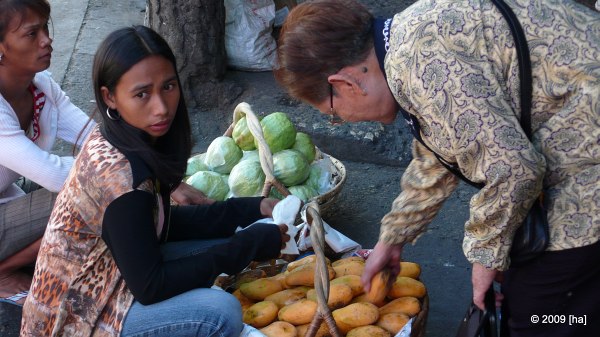
The next guy I almost missed when snapping without looking…
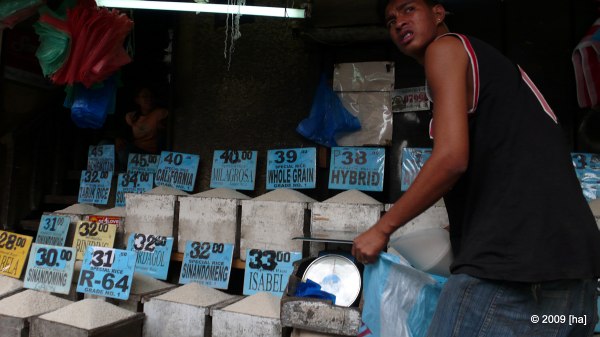
The next one is post-processed. Not just the crop, but also the background blur that, as mentioned above, is impossible to achieve out of the camera. As using GIMP is not one of my favorite pastimes, I did it rather quick-and-dirty; you can see artifacts around the hat, for example, that could have been avoided by more careful work.
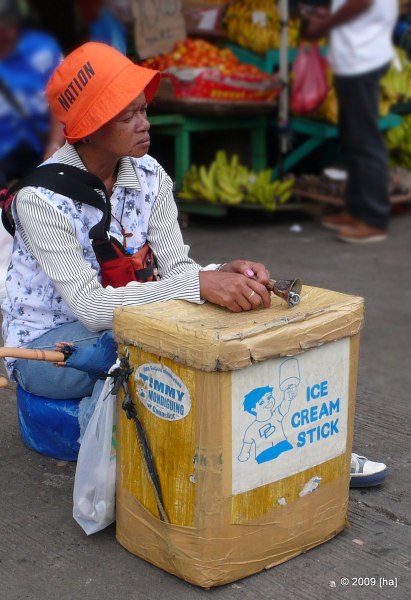
Another one from the edges of Baguio’s market area. Actually, one of my favorites. Why, I hear you asking, there isn’t really anything special in this picture, is there? Yes, correct at first glance, I’d say, but if you look more carefully, you can see that there are many stories, many lives going on in this small area of Baguio city space.
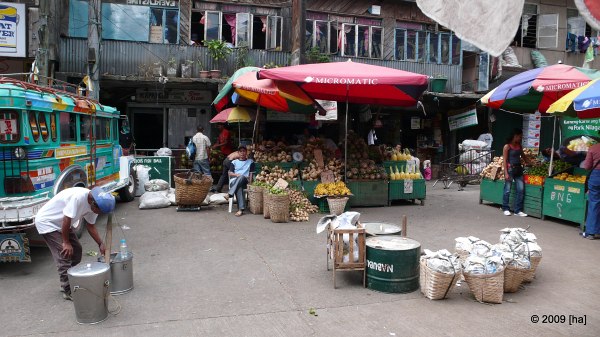
I was amazed to see that Andean musicians exist also in the Philippines:
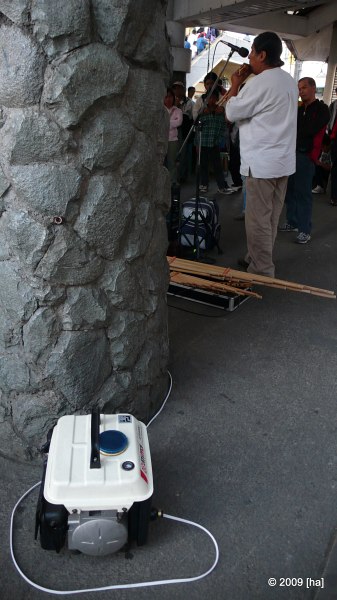
But the real reasons for coming to Baguio at this time of the year are neither its pine trees nor its market nor its street musicians. Well, at least not the variety shown above. It’s the annual flower festival “Panagbenga” that culminates in a weekend of two processions, Saturday and Sunday morning. That’s exactly when I was there, and, believe me, it took me many a phone call to find a hotel room…
Processions are scheduled to begin at 8 am, but when you go there at 6 as I did, you’ll already have a hard time to find a decent place to see the action. Fortunately I am taller than 99.9% of the local population… This does not make for great picture taking conditions; nonetheless, here are a few from this event. They really did put on a fantastic show.
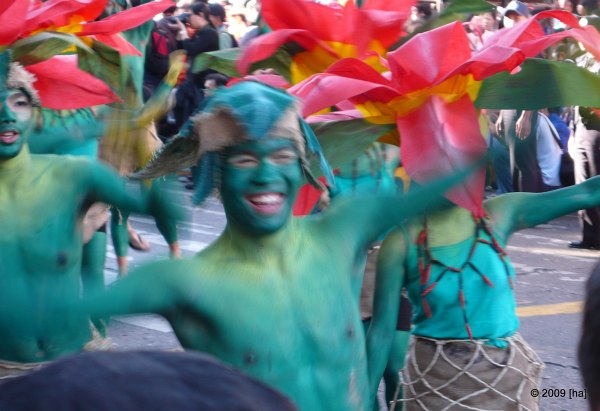
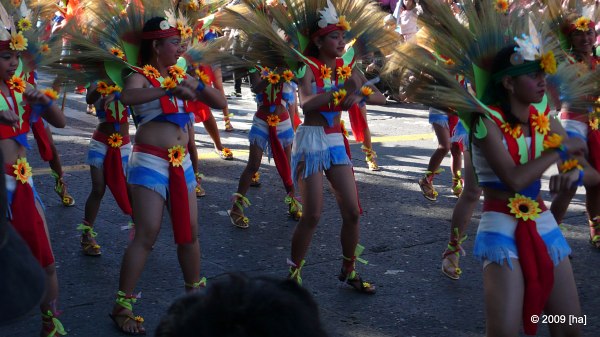
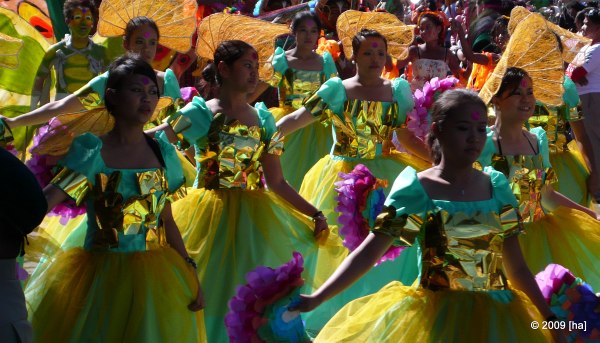
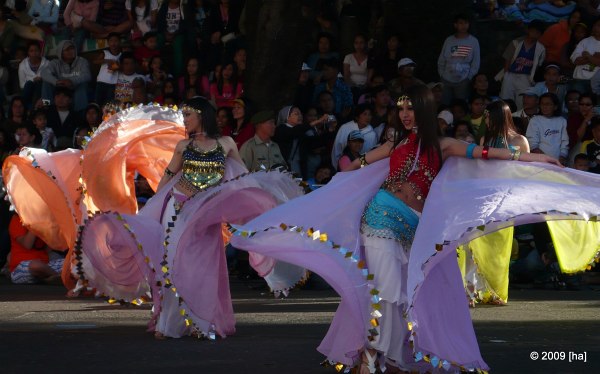
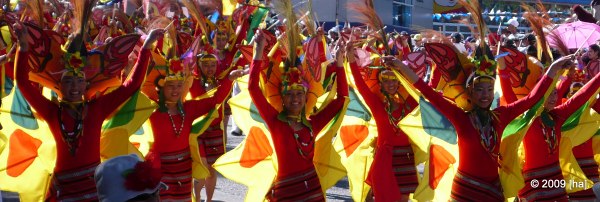
The above pictures were taken with manual focus. Having several times missed the scenes I wanted to capture by a split-second because of the camera’s focusing time, I finally switched to manual focus and, voila,
this worked perfectly. For once, I could take advantage of the wide depth of field…
Next stop of my journey was Legazpi City in Southern Luzon. It is known mostly for Mt. Mayon volcano, as seen behind the rice fields in the picture below:
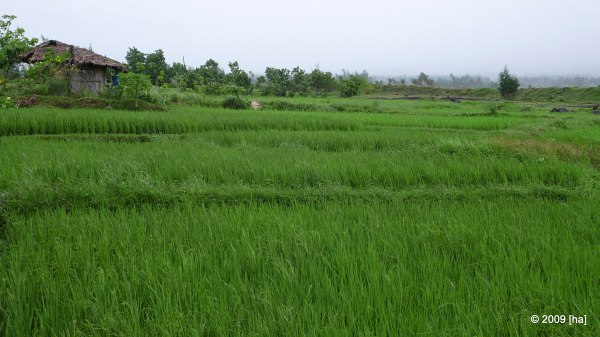
You don't see a volcano? Well, neither did I… It was raining all day, and the "most perfectly shaped volcano" was hiding in the clouds. Only shortly before nightfall, it became at least partly visible behind downtown Legazpi:
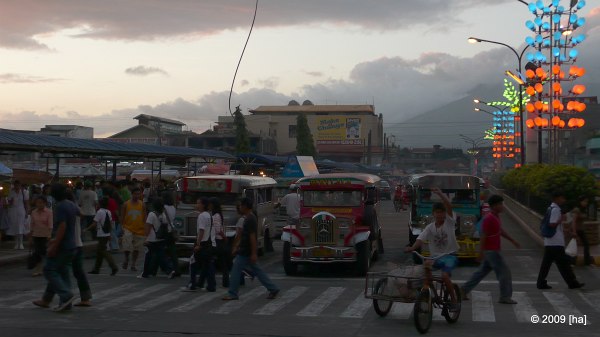
Here's another one:
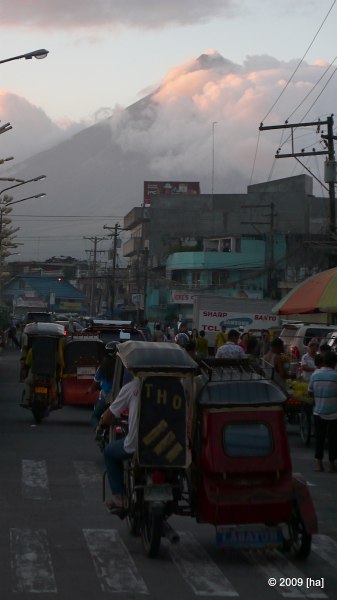
Form Legazpi City, I took a van on to Donsol in Sarsagon province, a friendly little place known for its whale sharks. Given that my camera is not waterproof, I can't show you any of those, but a few impressions of the Sarsagon countryside…
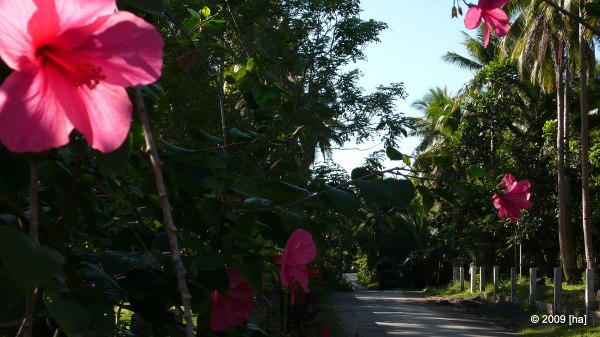
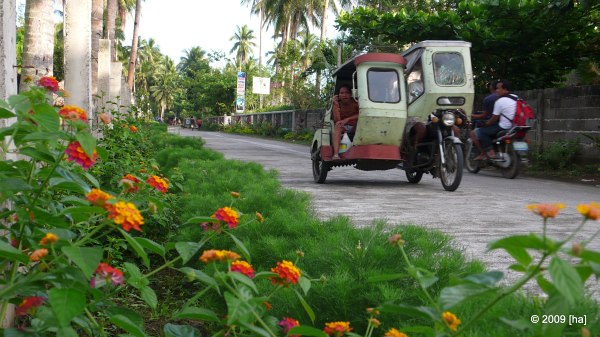
… complete with the ubiquitous sunset:
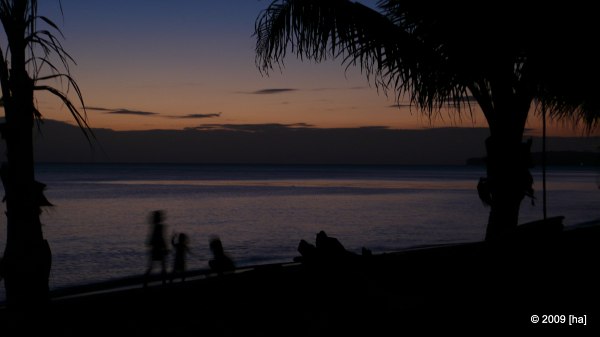
Returned from Southern Luzon and spent the weekend in Puerto Galera, off Batangas on Northern Mindoro. With the rise of nearby Sabang and White Beach, the tiny village of Puerto Galera apparently became a bit neglected. While coconut shells on the beach can make for a nice picture, they don’t actually invite you to stay there and go for a swim. Cleaned up, it would have been a great place.
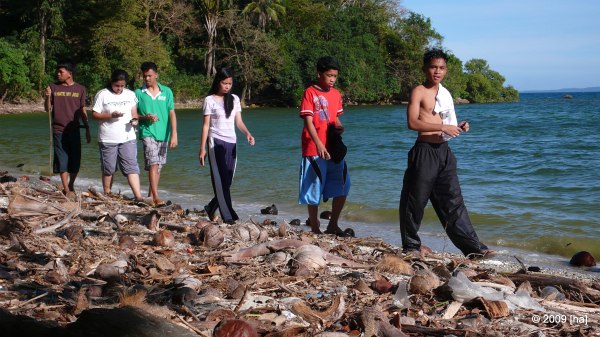
The next one, taken on the outskirts of Sabang, shows just how it could be. I used fill flash to brighten the yellow clothes of the girl taking a picture of her aunt right after sunset.
I have never been to Pattaya, but from what I’ve seen written on it, I guess that Sabang must be something of a miniature version of that town. Frankly, not my cup of tea, and probably only attractive if you are at least half drunk. I only went there for the beach and then back to Puerto Galera proper. Locals helped finding a motorcycle to take me back for a reasonable fee as public transportation is non-existent at night.
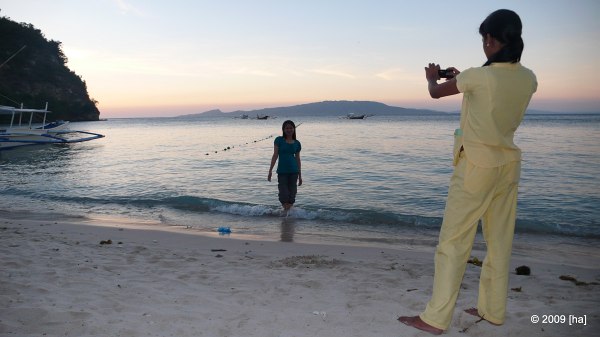
Going back to Batangas, an outrigger ferry crew member resting before the trip:
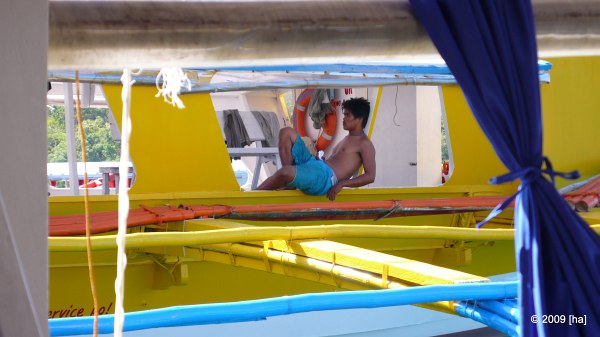
After that weekend excursion, I left Luzon again and flew to Dumaguete on Negros island. They have a curious version of the tricycle, huge by comparison, that somehow reminded me of stagecoaches:
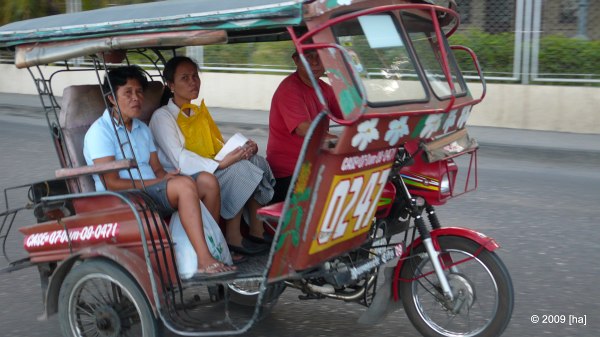
And there are thousands of them, as shown here in downtown Dumaguete. Apparently, they don’t just serve as taxis but also as family vehicles as there are only very few private cars to be seen in the more remote parts of the Philippines.
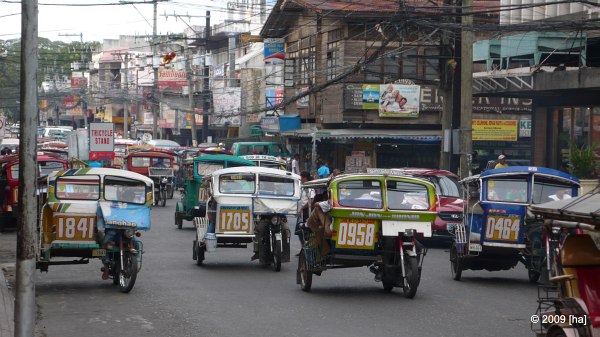
Crossing the road in Tricycle City:
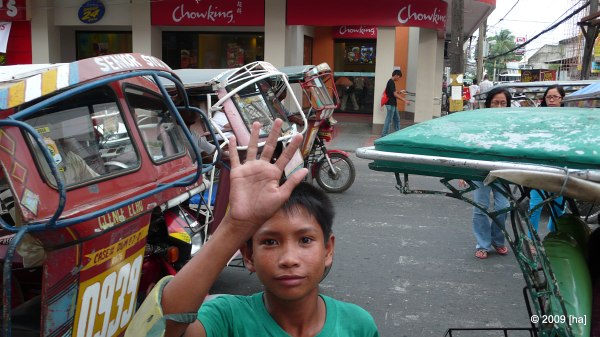
The impressionist appearance of the following picture was not achieved via post-processing, but entirely within the camera, by slight over-exposure and motion blur. Well, I told you those Dumaguete tricycles fascinated me…
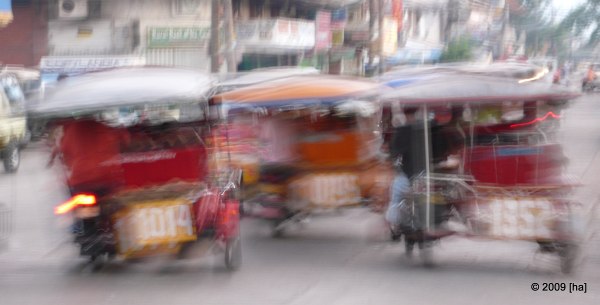
But they do have other vehicles, too. This one could be called “Waiting for the Ferry”:
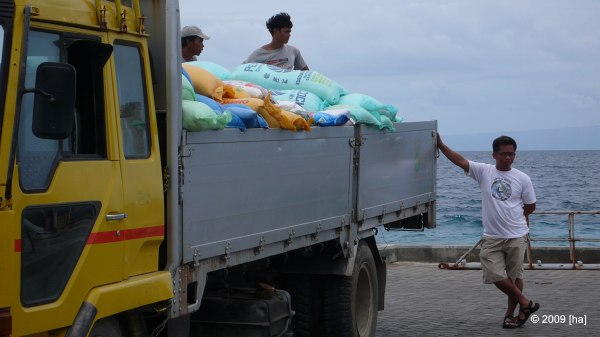
On to the small island of Siquijor for two days of beach life before returning home. I think that the following photos illustrate well the use of a (moderate, 28mm equivalent) wide-angle lens:
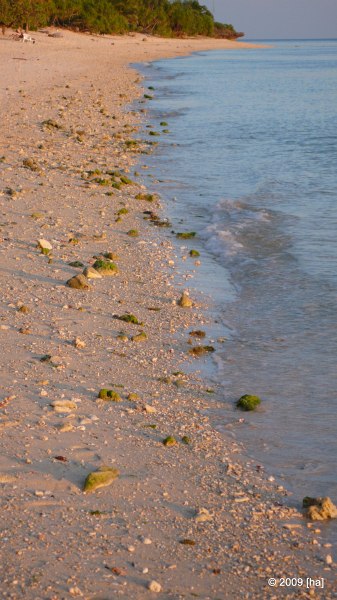
However, even a small-sensor compact camera cannot show the entire world right from the front lens to the horizon in focus. But almost: the piece of coral was maybe 5 cm from the lens.
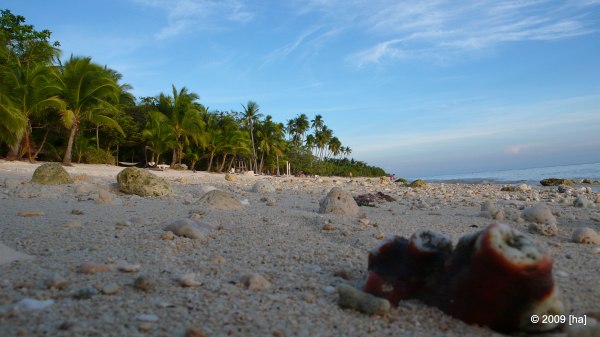
It's called "Coco Grove" for a reason:
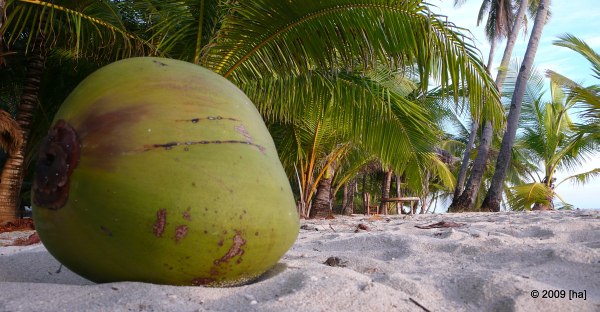
Locals keep their boats between the palms, a few steps from the beach.
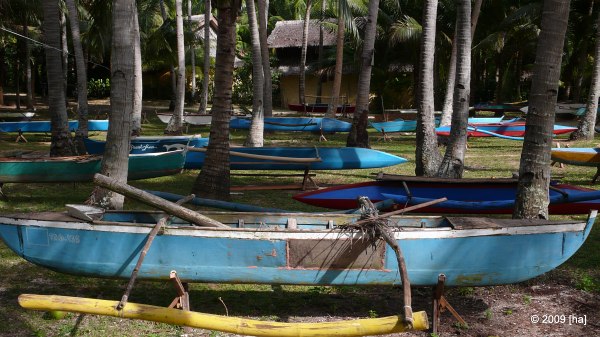
When it is time for taking to the seas…
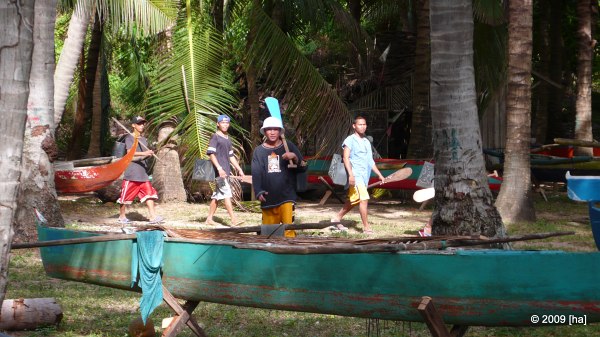
… they simply carry them to the water.
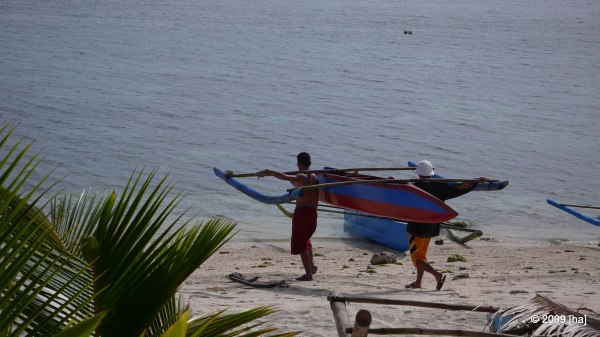
Of course, I did not just stay on the beach but also walked around a bit in the “real world”. Two scenes from Siquijor’s ring road:
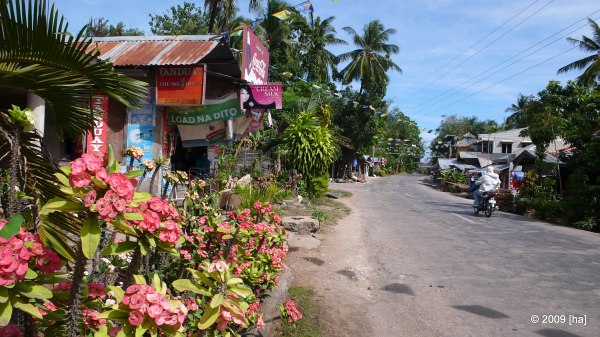
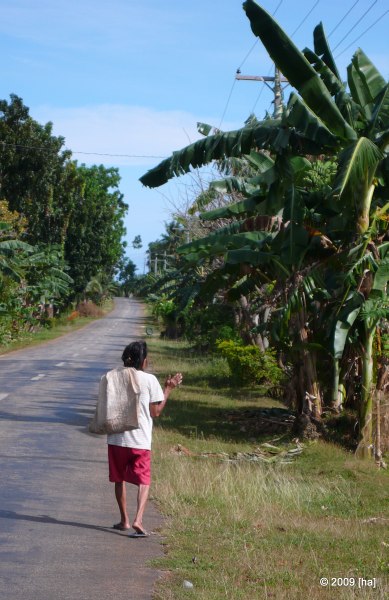
Now it was time for me to go home. Let me end this series with, once again, a Philippines specialty, the sunset:
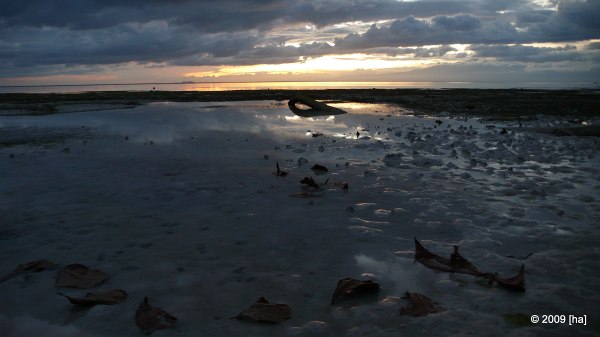
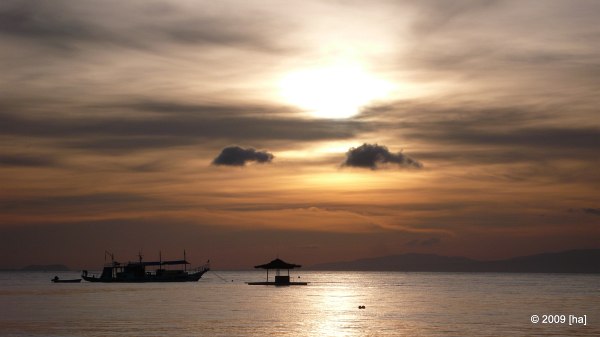
That's it. Hope you enjoyed it. Comments are welcome.
Tom
Tom’s Summary:
Hello Steve,
Remember me? A couple of months ago we had a long discussion on analog versus digital.
I spent 4 weeks of vacation in the Philippines recently and had to make the choice which camera to take. This actually was a very tough decision.
On the one hand, I had my good old Contax SLR with its Zeiss primes. 20 years ago, when I bought it, arguably some of the best equipment money could buy, perhaps only rivaled by Leica's fine products for, alas, three times the price. And if tests published in magazines on- and offline are to be believed, it apparently would be hard even today to find a match for those lenses.
On the other hand, my Panasonic Lumix LX2 compact camera that I bought less than a year ago. One of the best compacts available then, I'd say, but absolutely no match for the Contax in terms of image quality.
Then why did I say that this was a tough choice?
Well, the Contax equipment weighs in at about 5 kilograms. Not much for a professional photographer, I guess, but a lot for someone like me who is primarily travelling around using public transportation and his own feet, and who just happens to take a camera with him. In fact, especially during the last couple of years, I found myself leaving my camera at home more and more often simply because I didn't want to carry its weight, or didn't have the room for its bulk.
So, in the end, I decided for a compromise: I would put the Contax with just three lenses (2.8/25, 1.4/50, and, of course, my favorite 1.4/85) into a small and very lightweight bag and bring the Lumix as well.
Now which camera have I used more often?
Surprise: I exclusively used the Lumix. It was just so convenient to have it with me in a small belt pouch wherever I went; I never felt the desire to burden myself with another bag. Still, there have been a couple of situations where I would have loved to use the Contax, but how much sense does it make to come home with 900 digital and 100 analog images? That would have left either series incomplete.
So you might say that digital won over analog hands-down, even though this didn't really have anything to do with the question of digital versus analog… In fact, with the problem of a suitable output device still existing, I would much prefer to have the results as analog slides now. Well, you can't have everything at once…
Apart from this, does it mean that I am fully happy with the Lumix? It sure is a great little camera, but the answer is "no" nonetheless because it does have a couple of severe shortcomings.
• Most important for me is the fact that, caused by the small sensor and slow lens, it is impossible to have a limited depth of field. Even wide open at the telephoto setting of the zoom lens, most of the picture will appear in focus.
I'd say that with the SLR, I took about half of my pictures at f 1.4 to f 2.8, so the lack of selective depth of field is really limiting me.
• I miss a viewfinder for a couple of reasons.
First, I find it hard to see every detail on a small low-resolution LCD screen, especially if there is a lot of light around you. I have a couple of pictures that I could have done much better had I only seen the electric wire throwing a shadow on the face of the subject, for example.
Second, I find it very difficult to keep a camera steady if I hold it in front of me instead of being able to press it against my eye. Despite image stabilization, I'd say that about 30% of my pictures show motion blur and/or tilted horizons versus maybe 5% with my un-stabilized SLR.
• The Lumix's lens is not bad. But it produces strong distortion and is very sensitive to flare. Probably not more so than other zoom lens, but there is a reason that I explicitly have never bought any of those for my SLR…
• Low-light performance is poor. It is a known weak spot of this camera, and apparently its successor performs much better in this respect. Even at ISO 100, there is visible color noise in the darker parts of the image. Higher ISOs can only be used for, say, documentary purposes.
Of course, some of the shortcomings mentioned can be overcome by digital post-processing, but frankly, as an old slide photographer, I still have the idea that the picture should be fine the way it comes out of the camera. I don't like to spend a lot of time in front of a computer to make it right.
———————————-
So if I had a free choice, which camera would I get? I have done a bit of market research and have held pretty much every single DSLR available today in my hands, and here are my findings:
I have said earlier that a logical choice after the Contax would be a full frame DSLR. Well, I have to take this back. I have absolutely no idea why those cameras (and also their lenses) have to be that HUGE, but as long as this is so, they are not for me. Camera makers, listen up: Why don't you give me the modern-day equivalent of an Olympus OM or a Pentax M system? I might be very interested in that.
On the other end of the sensor size, there is the 4/3 format of Olympus and Panasonic. Quite easily, those cameras disqualify themselves by their tiny viewfinders. Also, the lens lineup is very limited.
Finally, the bulk of the lot, the various APS-C-format cameras. Admittedly, I am not impressed, either. The same problems as above. Small viewfinder and/or big body size, as well as limited range of high-quality lenses.
While there are tons of slow, often mediocre quality "standard" zoom lenses out there, there is a serious lack of fast, high-quality lenses, especially but not limited to the wide-angle range. It's pretty much the same for every manufacturer. Why can hardly anyone offer me the equivalent of a 2.8/20, 2.0 or maybe 2.8/28, 1.4/50, 1.4/85, 2.0 or 2.8/135 and 4.0/200 lenses? Not to mention, all of those in a single system?
So, frankly, what is available on the market right now does not make me feel like opening my wallet and pulling a lot of money out of it.
Oh, I forgot: There is the Leica M8. In fact, I might be seriously interested in this one if it were available for about one fourth of its price — which would still make it one of the more expensive cameras around…
———————————-
What are the most interesting trends for me?
For one, it is compact cameras with larger sensors for improved image quality especially at low light, as well as increased depth-of-field control. I think that Sigma's DP1 / DP2 go into the right direction but are poorly executed. How can anyone even *think* about putting an f4 lens into such a camera?
Most interesting, however, is the micro-4/3. This could have a lot of potential for me *if* Panasonic / Olympus decided not to offer yet another range of slow, mediocre quality "standard" zoom lenses but something more closely resembling the lens lineup I mentioned above. And this with at least the same quality, but even smaller, than the Pentax Limited lenses. Unfortunately, I don't have the impression that this is going to happen.
And here we are at what I would buy if for some reason I *had* to buy a DSLR system today: It would be a Pentax Km (aka K2000 in some remote parts of the world, as far as I know…) with the 4.0/15, 3.2/21, 1.9/43 and 1.8/77 Limited lenses. Why this? Well, the camera is relatively small (though still bigger than my Contax), has a relatively large viewfinder (though still much smaller than my Contax) and offers most of the features I would want. Also, I like the ergonomics of Pentax best — and Canon's, by the way, least. The lenses are 1/2 f-stop slower than I would like them to be but, in exchange, small and relatively lightweight (given their metal construction), and their optical quality seems to be not too far from what I'm used to from my Zeisses. In fact, Pentax, listen: Why don't you add the metering mode selector switch, the depth-of-field preview switch and, most importantly, the viewfinder of the K20 to a Km mark II? You might get a new customer…
———————————-



